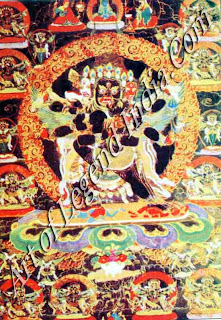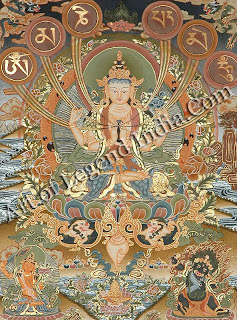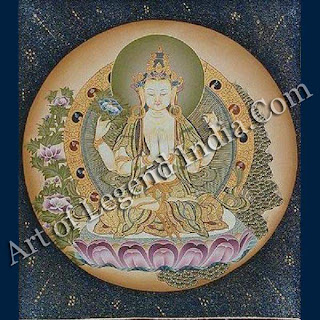The
Yi-dam is represented in yab-yum with their saktis signfyir Honourable Father
in the company of Honourable Mother. The Yi-dan in fact is Five Dhy5ni Buddhas
with their mystic consorts in yab-yul attitude. Every lama chooses a Yi-dam
(istadevata) for his spiritual guidanc and protection either for his life-time
or-for some special task as it is con sidcred more efficacious to worship a
tutelary god with his consort. The, Yi-dam are both in angry and pacific forms.
The mild Yi-dam are crown ed Buddhas represented with princely garments and
Bodhisattva orna merits while the angry Yi-dam show Dharmapala ornaments and
attributes.
Sang-
Dui (gsang-hdus) is the main deity of the Guhyasamja Tantra (Tantra of secret
communion) and is portrayed in the centre of the thanka. Sang- Dui which
signifies Guhyapati or Master of secrets is the Tantric form of Vajradhara
represented in mystic yab-yum embrace. Yab and 'um, the Mystic Father and the
Mystic Mother are represented seated on lotus and have three heads and six
arms. The central head of the god is ferocious with a third eye on the
fore-head while the rear faces are placid in appearance. Each head is adorned
with a five-leafed crown and his high u.sta.sa is surmounted by a flaming
jewel. Both Tab and yum are portrayed decked in Bodhisattva ornaments and
garments and they display the same attributes. The principal hands of Sang- Dui
are crossed at the back of his Sakti holding vajra and ghanta (bell) in
vajrahum karamudra while the upper arms of the Sakti encircling the neck of the
god represent the vajra and the bell. Both Sang- Dui and his Sakti hold vajra
and the lotus flower in their right hands and the sword and cintamani in their
left hands.
Sang-
Dui is an embodiment of Sunya, the highest reality while his Prajna (Sakti)
symbolises karrua (compassion) and they spiritually merge into an oneness, a
mystic unity and the duality ceases leading to eternal bliss and highest state
of nirvana. Along the margin in rows, divinites and monks are placed in the
arched compartments. The right and the left rows represent the peaceful aspect
of the god while the figures at the bottom exhibit the wrathful aspect of Sang-
Dui. At the top are portrayed Vajradhara- and Vajrasattva and the lineage-gurus
or preceptors of the Guhyasamja.
Stylistically
this thanka is closely related to contemporary Nepali patas especially in the
depiction of miniature character of the framed compositions along the margins
and in the delineation of the figures and their attributes and in the rendering
of ornamental details.
Vajrakila,
a deified phur-bu, the magic nail or kila is used by the exorcist to nail the
evil spirits. Vajrakila was the tutelary deity of the rNim-ma-pa sect, the old
school and later of the rNim-ma-pa sect; the lamas of both sects contributed
greatly to the diffusion of the Tantric cult of Vajrakila. The image of
Padmasambhava on this thanka assigns it to the rNim-ma-pa sect. Padmasambhava
is the founder of this religious body
The god
is represented with three heads, six arms, four feet and two wings and is
considered to be an aspect of Heruka. The central face is black while the right
and left faces are in white and red colour. All the faces depict a terrific
expression with three rolling eyes, flaming eye-brows and red gaping mouth. He
is decorated with ornaments and his head is crowned with five skulls surmounted
by flaming jewels. He is also decked in ornaments of serpents and bones (sanmudra)
and his neck is adorned with garland of human heads (naramundamala). With his
two upper arms in the 'right and the left he holds vajra and fire along with
skins of man and animal. The next pair of hands holds vajra and trident. In the
other pair of hands he grasps phur-bu embracing his Sakti. Vajrakila stands in
pratyalidha pose on lotus and tramples upon two rudras, male and female,
symbolizing hope and despair. His Sakti is represented embracing the god and
holding cakra in the right hand and offering kapalla, full of blood, to god, in
the left hand. The god is encircled by flames and sur-rounding him is the cycle
of ten krodhas or the ten representations of Herukas. Four hypostasis of the
god in the form of phur-bu nailing dead-body are also seen representing the
guardians of four directions according to vajrakitiya tradition.
At the
top, in the centre is Vajradhara with Padmasambhava, the founder of Lamaism and
Jnanasagara (Mandrava), the female disciple of Padmasambhava on either side.
Just immediately below the deity, in the centre is the representation of
Tantric offerings of five senses in a skull-cup placed on three smaller skulls
on a dead-body containing torn out eyes, ears, nose, lips and heart Of the
enemy of the sacred doctrine. On either side of this horrible sacrifice are the
figures of four bird-headed door-keepers of the mandala.
Writer
– Sipra Chakravarti
Subscribe to:
Post Comments (Atom)















0 Response to "Thangka Art- Yi Dam or Tutelary Deities"
Post a Comment